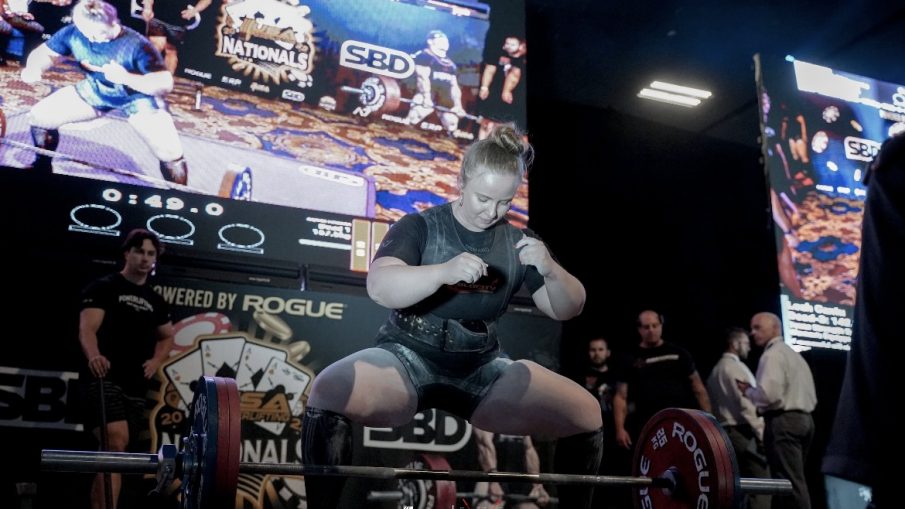Written by: Kevin Cann
Coaching should focus on developing the intuition of each given lifter as this is where their own elite levels of performance lie. At the top of the hierarchical skill acquisition pyramid is “unconscious competence.” This is where the athlete is just flowing in their environment without thinking about anything. This is typically referred to as being in the zone, but it is a subconscious engagement with the environment at a high level.
Right below unconscious competence lies conscious competence. This is where most coaches and lifters will live. Coaches will utilize verbal feedback to attempt to get the lifter to execute the movement in a better way. This verbal feedback engages the consciousness of the lifter as they will focus on doing that thing that the coach suggested.
Proprioception is a subconscious process. It exists out of our awareness. When we engage our consciousness, we decrease the strength of the signals being received by our subconscious. This is very limiting because we learn movement by that subconscious communication between muscles and brain. This tends to slow down the lifter as well which will have a negative impact on force production.
Most programs do not give the athlete opportunities to develop this intuition either. The brain wants to conserve energy and will develop higher levels of coordination for movements that can have a lot of crossovers to different things. It does not care so much about a single movement. Therefore, variability is extremely important for skill acquisition. By varying the lifts, we encourage the brain to develop higher levels of coordination because doing is so now conducive to performing different movements within the environment. Novel movements also catch our attention which sets the stage for greater learning.
A program that focuses solely on adjusting volumes and intensities, will not develop this intuition in the same way. This can only be effective if the athlete is built for the sport or had a background where there were higher levels of variability in their experiences. This leads to a powerlifting culture of either you have it or you don’t as programs like this will not develop lifters with less overall athletic experience or less than ideal leverages.
These programs also fail to develop the decision making of the athlete. High performance is a coordination of thousands of subsystems, most we can’t see or even identify. The athlete needs to learn how to navigate training as they will know themselves better than anyone else will. Just identifying an RPE after a set is not enough to develop a training skill.
Intuition is developed through intellectual knowledge merging with experiential knowledge. Developing intuition also takes time. The average person will take 5-10 years to truly develop into an elite lifter. I understand that most will not want to make this commitment, but there are some that do.
The process needs to include education about the history of the sport, physiology, anatomy, and training theory. It also needs to work on developing the appropriate mindset. This starts with meditation. Meditation allows us to be aware in the present moment, which is what we need when we are training.
Meditation also strengthens our ability to learn movements as it strengthens the parts of our brain that are responsible for proprioception. Most of what we do is driven outside of our awareness, but we give it conscious attention which gives us a fall sense that we are in control. Our consciousness can help influence the subconscious, but that is more a matter of willpower and is very limited. Meditation strengthens the conscious brain in a way that allows it to have greater strength over the subconscious. However, this too takes a very long time to get to that point.
In training the lifter needs to have experiences that match the sensory input of the main lifts but varies enough to develop higher levels of coordination. This is the typical max effort method in a conjugate program. Another good example of adaptation occurring outside of our awareness is with dynamic effort work.
Dynamic effort is in the program not to increase max strength, but to increase the rate of force development. It is in there for the lifter to learn to elicit more motor units more quickly to be able to reach max force faster. None of this can be felt by the lifter or controlled. The lifter needs to use the right weights and move them as fast as possible.
The argument that speeds work is too light is very ignorant. Yes, it is too light to increase max strength in and of itself, but that is not why it is in the program. The bar must move at certain speeds to develop the rate of force development. For it to work with the powerlifts, bands need to be used. This cannot work with straight weight due to the deceleration on the barbell at weights under 85%. If bands are not an option, the submax effort method is more appropriate and the training needs to be modified in a way that reflects that.
Sleep is also important here as that is where the connections between neurons are made permanent as well as the muscles, ligaments, and tendons recovering. Without sleep, coordination cannot be improved. A body in recovery will only seek homeostasis. You cannot get stronger in that case.
No matter what program you do, at some point you will get stuck if you do not address these components. You can only get so far just showing up to the gym and doing what is on a spreadsheet. The environment you lift in matters more than you think as well. Find a strong gym and good training partners to push you and hold you accountable. Greatness doesn’t happen alone.
As a lifter you need to commit to this process and be honest and accountable. You are not owed anything.

